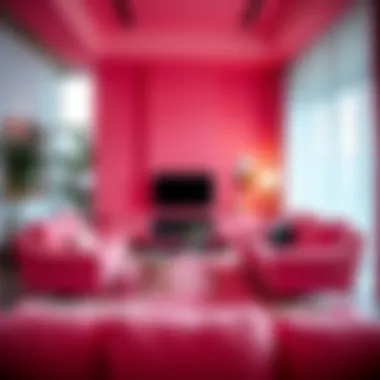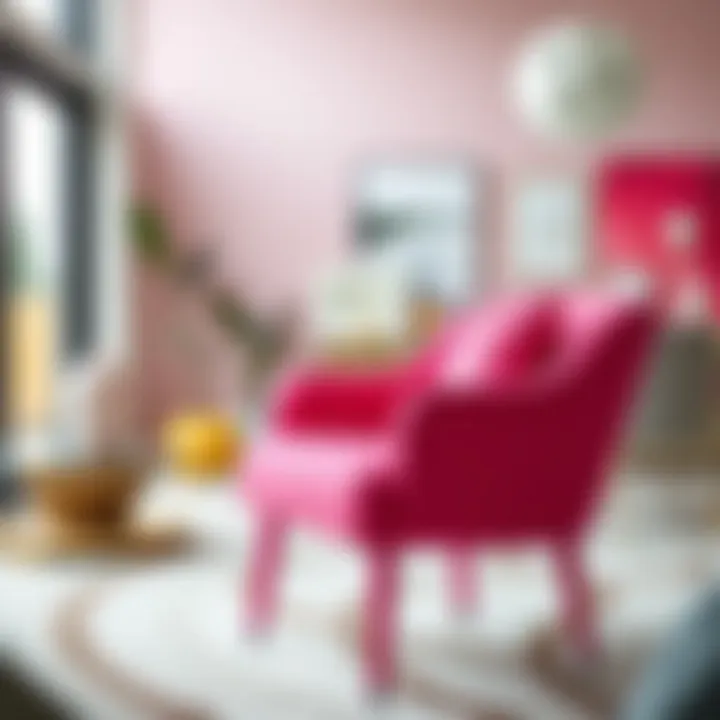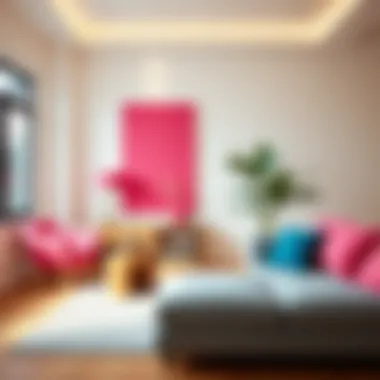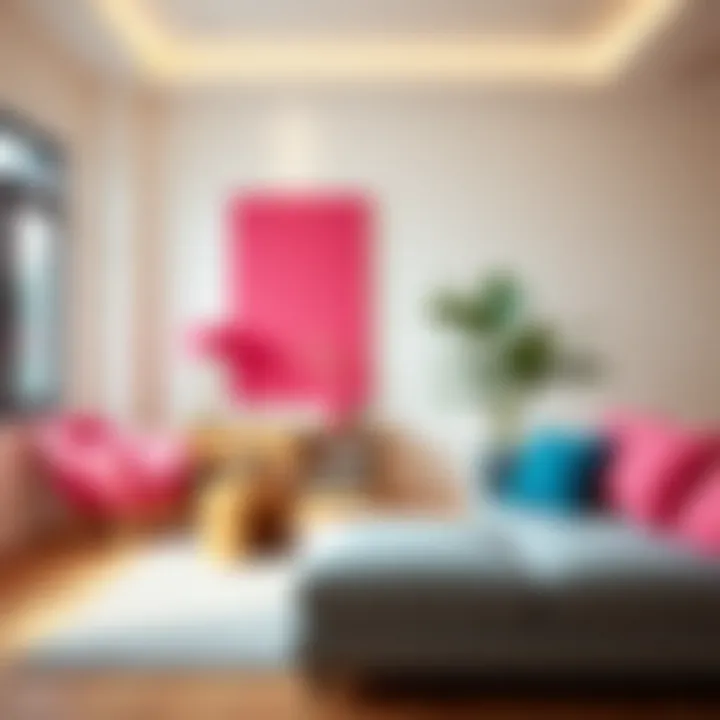Exploring Bright Pink in Furniture Design


Intro
Bright pink often evokes feelings of cheer and vibrancy, yet it remains, surprisingly, one of the more underused colors in furniture design. Despite its potential to evoke a lively atmosphere, many homeowners and designers hesitate to embrace this bold hue. This article explores the aesthetics and functionality of bright pink in the realm of furniture design, serving as a guide to marrying beauty with practicality. The discussions will traverse the historical associations that have shaped our perception of this color, delve into its psychological effects, and unravel contemporary trends that are reshaping living spaces across the globe. With each section, the aim is to illuminate how this eye-catching color can both enhance interior aesthetics and fulfill functional needs, leading to well-rounded living environments.
Furniture Design Trends
Current Styles and Aesthetics
Furniture design is a canvas of creativity, where trends ebb and flow like the tide. Currently, bright pink is making a splash, finding its way into modern aesthetic paradigms that prioritize both fun and sophistication. Pairing this hue with sleek lines in Scandinavian designs or soft curves in mid-century modern pieces creates an inviting ambiance.
Consider browsing furniture collections from brands like West Elm or CB2, where bright pink appears on upholstered sofas or accent chairs, injecting life into otherwise muted environments. It’s not just about color; it’s about its placement and the textures that accompany it. A bright pink velvet sofa can be a stunning centerpiece, especially when paired with neutral palettes, allowing it to shine without overwhelming the room.
Color Palettes and Materials
To truly harness the power of bright pink, blending it with complementary color palettes is essential. Think along the lines of:
- Warm Grays: Soft, understated hues can tonally balance bright pink, creating a cozy atmosphere.
- Deep Blue: Adds richness and character, making pink pop while maintaining elegance.
- Earthy Greens: Introducing natural elements fosters a harmonious vibe, pairing vibrancy with calmness.
When it comes to materials, bright pink lends itself particularly well to textiles. Fabrics such as velvet or linen amplify its visual appeal, adding depth and texture. Wood accents, particularly lighter woods like ash or birch, can counterbalance the intensity of bright pink, infusing warmth into the overall design.
"The key is not to drown in a sea of color, but to create islands of vibrancy amidst grounding shades." - Design Expert
Buying Guides
Essential Considerations When Purchasing
Purchasing furniture is not just about aesthetics; functionality is equally important. Here are a few tips to keep in mind:
- Space Requirements: Measure your area to ensure the bright pink piece doesn’t crowd your space.
- Versatility: Opt for items that allow for easy seasonal changes or rearrangements. A bright pink ottoman, for instance, can serve as both seating and a decorative piece.
- Maintenance: Understand the care that certain materials require. Bright colors might need more attention to keep them looking pristine.
Top Recommendations for Different Budgets
- Low Budget: Look for thrifted furniture that can be repainted in bright pink. A little DIY magic can turn an old chair into a statement piece.
- Mid-range: Brands like Wayfair offer affordable bright pink options that don’t compromise on style, such as accent chairs or side tables.
- High-end: Consider bespoke pieces from luxury furniture makers like Roche Bobois, where bright pink can be tailored to your specifications and crafted from high-quality materials.
Incorporating bright pink into your furniture design doesn’t have to be a daunting task. With the right approach and an open mind, this vibrant hue can elevate the aesthetic and functional value of any living space, transforming the ordinary into the extraordinary.
Understanding Bright Pink
Bright pink isn’t just a shade that might make you smile; it plays a vital role in the world of furniture design. Understanding bright pink is essential for anyone looking to incorporate this color into their spaces, whether you're a homeowner, designer, or DIY enthusiast. It's not merely about aesthetic appeal; it’s also tied to the emotional and psychological responses that this vibrant hue can evoke.
In the realm of furniture, bright pink offers a versatility that can breathe life into dull settings. This lively color can serve to enhance mood, create focal points, or establish a unique personality in a room. With the right approach, bright pink can also foster balance in a space, harmonizing with other colors and textures.
What Defines Bright Pink?
Bright pink can be seen as a bold variant of the color pink, characterized by its energetic and vibrant appearance. It’s distinct from softer pastels or muted tones, setting the stage for energetic interactions and communication within a space. While some may perceive pink as a shy and delicate color, bright pink stands firmly on its own, demanding attention and sparking intrigue.
Historical Context of Bright Pink
Evolution of Color Perception
The evolution of color perception tells a rich story that has influenced numerous design choices, including the embrace of bright pink in furniture. Over centuries, colors were laden with different meanings and reactions, often dictated by cultural norms and societal changes. Bright pink, with its vibrant nature, has transitioned from being associated primarily with femininity to being embraced across various demographics and styles.
Bright pink was once seen as a color reserved for children or soft, delicate environments. However, as social attitudes shifted, especially in the mid-to-late 20th century, the perception began to evolve. This color became a symbol of boldness and creative expression, appealing actively to those wanting to make a statement or challenge societal norms. This evolution plays an integral part in its role within the furniture industry today; bold choices reflect confidence in personal taste.
One significant characteristic of this evolution is how bright pink can either uplift or dominate a design. Used carefully, it can enhance spaces, while employed excessively, it might overwhelm. Therefore, understanding this dynamic is essential for optimal design.
Cultural Significance Across Eras


The cultural significance of bright pink is multifaceted, revealing its transformation across eras. In the 21st century, pink has evolved from a color deemed merely feminine to one recognized for its versatility and capability to signify various feelings—joy, love, and even rebellion. This transformation is especially prominent in the realms of art and fashion, where bright pinks are frequently utilized to make bold statements or provoke thought.
Each era has imparted its own meaning to bright pink. For instance, in the 1980s, it became a symbol of excess and creativity, linked to pop icons and flamboyant design. More recently, bright pink has made headway into the eco-conscious movement, aligning itself with causes that celebrate individuality and self-expression in sustainable practices.
In today’s furniture design, embracing bright pink offers a unique opportunity to stand apart from more traditional choices. While it can attract attention, it also requires careful consideration of placement and partner colors for a balanced aesthetic. The advantages of utilizing bright pink include its ability to enliven a space and infuse it with personality, yet care must be taken to blend it harmoniously with other elements.
"Colors are the smiles of nature." - Leigh Hunt
In summary, bright pink’s importance in furniture design cannot be overstated. Understanding its definitions and historical contexts provides a deeper appreciation of how such a vibrant hue can enhance style and emotional resonance in living spaces.
The Psychological Impact of Color
The effectiveness of colors in our lives stretches far beyond mere visual appeal. In the realm of furniture design, the significance of understanding these effects cannot be overstated. Each hue can evoke emotions, set moods, and even shift perceptions of space. Bright pink, in particular, is a color that seems to dance between vibrancy and warmth. Its application in furniture is not just stylish; it has deep roots in psychological responses that make it a compelling choice for homeowners, designers, and DIY enthusiasts alike. Whether it sparks joy, comfort, or energy, bright pink carries a weight of emotional undertones that deserve exploration.
Associations of Bright Pink
Emotional Responses
When one thinks of bright pink, the first wave of feelings often oscillates between excitement and warmth. This color is rich in its associations; it can be comforting like a cozy sweater, yet energizing like a morning sunburst. For many, bright pink symbolizes love and compassion, tinged with a playfulness that can elevate any room it occupies. Bringing this color into a living space can invite an air of optimism and creativity.
One compelling characteristic of bright pink is its ability to inspire a sense of welcome. From a psychological standpoint, a well-placed bright pink sofa or chair can make guests feel at ease, encouraging interaction and communication. This characteristic makes it extremely popular in family rooms or social spaces where bonding is paramount. However, there’s a caveat; too much of this exuberant color can feel overwhelming. If used excessively, it may lead to feelings of agitation rather than serenity, highlighting the necessity for a balanced approach.
Reactions in Different Settings
Bright pink doesn’t gaze into a one-size-fits-all mirror. Its impact shifts dramatically depending on its surroundings. In a bustling cafe, for instance, bright pink furnishings might infuse energy and vibrant conversation amongst patrons. On the contrary, in a personal bedroom setting, the same hue may create a stark contrast that could either elevate mood or disrupt tranquility.
This colorful chameleon effect makes it a versatile choice for home designers. Its ability to juxtapose with other hues also plays a critical role in how it’s perceived across various environments. Bright pink can provoke joy and animation in child-centric areas, while in adult settings, it can create a sophisticated undertone when paired with muted colors or metallic accents.
However, it’s important to be mindful of the placement and pairing of bright pink in these different settings. While it can amplify excitement in a playful environment, it might throw off the balance in spaces meant for relaxation or concentration.
Color Theory Overview
Understanding the dynamics of color theory is crucial when working with bright pink in furniture design. This framework not only assists in selecting the right hues but also illuminates how the color interacts with space and mood.
The Color Wheel
At the heart of color theory lies the color wheel. It visually represents the full spectrum of colors. Bright pink occupies a unique spot, resting in a space that allows it to harmonize with both warm and cool tones. Its placement suggests it can serve as a connecting bridge among colors, opening avenues for creative combinations.
Utilizing the color wheel can lead to effective decisions in furniture design. The vibrant nature of pink is complemented beautifully by softer pastels or even deeper, contrasting colors like navy blue or forest green. This flexibility makes bright pink a fabulous addition to both modern and eclectic designs. However, failure to consider these relationships may leave the design unappealing or disjointed, reducing the overall impact.
Complementary and Contrasting Colors
The concept of complementary and contrasting colors is essential in maximizing the appeal of bright pink. Choosing colors that sit opposite to bright pink on the color wheel, such as shades of green, can create a visual punch that invigorates a space.
Conversely, contrasting colors allow for creativity without overwhelming the senses. While pink pairs well with neutrals, employing contrasting colors can yield vivid results that stagger the eye and invoke interest. This spectrum of choice illustrates why understanding color dynamics is a beneficial approach in the design process. The unique features of using these colors together not only enhance aesthetics but can subtly influence emotional reactions, creating a truly immersive environment.
"Color is the keyboard, the eye is the harmonium, the soul is the piano with many strings." - Wassily Kandinsky
In essence, working with bright pink in furniture design is not just about filling a space with color. It involves understanding how this bold hue interacts within its environment, what emotions it may elicit, and how it can harmoniously blend with other colors. Its application can transform a mundane area into something vibrant and invigorating, provided the nuances of color dynamics are respected.
Current Trends in Furniture Design
Current trends in furniture design indicate a significant shift toward colors and styles that not only beautify space but also resonate with deeper meanings. Bright pink, often overlooked, has started making waves in contemporary interiors. It offers a fresh approach that combines bold expressions with functional design, giving homeowners and designers alike a new palette to work with. Integrating bright pink into furniture pieces often reflects a modern sensibility that embraces individuality, creativity, and ecological mindfulness.
Emerging Styles Incorporating Bright Pink
Modern Minimalism
Modern minimalism has made a name for itself by prioritizing sleek lines and simplicity in design. At first glance, it may seem counterintuitive to mix minimalism with a vibrant hue like bright pink. However, when done right, this color injects personality while maintaining an uncluttered aesthetic. The key characteristic of modern minimalism lies in its restraint. Bright pink can serve as an accent while keeping the overall design clean and crisp. This juxtaposition creates an engaging focal point that draws the eye without overwhelming the senses. The unique feature of minimalism is that it embraces less, but by incorporating bright pink, the space gains unexpected vibrancy that resonates with positivity and energy. The drawback could be the risk of overdoing it; too much bright pink might clash with the minimal ethos, which emphasizes simplicity.


Eclectic Mixes and Unexpected Pairing
Eclectic designs thrive on creativity and the unexpected, blending various styles, colors, and textures to create a personalized space. Bright pink shines in this context as it complements an array of other colors, making it a versatile choice for experimental designers. The key characteristic of eclectic mixes is their embrace of contrast—mixing traditional with contemporary, bold with subtle. This method allows bright pink to coexist alongside natural wood tones or neutral grays, enhancing the overall design rather than overshadowing it. The unique advantage of this approach is its flexibility; bright pink can be featured prominently or subtly layered into the design, depending on the desired mood. However, without the proper balance, eclectic designs can quickly become chaotic and lose cohesion.
Bright Pink in Eco-Friendly Furniture
As sustainability grows in importance across various industries, furniture design is no exception. Bright pink can play a significant role in this shift, particularly when combined with eco-friendly practices. Integrating this bold color with sustainable ethics not only makes a statement but also promotes a mindful way of living.
Sustainable Materials
Choosing sustainable materials is paramount in modern furniture design. Bright pink can be quite striking when paired with materials like reclaimed wood, organic cotton, and bamboo. These choices not only support the environment but also give the furniture a distinctive character. The key characteristic of sustainable materials is their ability to minimize environmental impact while providing aesthetic appeal. When combined with bright pink, the result can be furniture that not only stands out but also tells a story of environmental consciousness. However, one has to keep in mind that not all sustainable materials can handle bold dyes evenly, which could alter the desired color saturation.
Ethical Manufacturing Practices
Ethical manufacturing practices ensure that the furniture is produced in a way that respects workers and the environment. This aligns seamlessly with the use of bright pink, as it can symbolize a fresh start while addressing larger issues within the industry. The key characteristic of ethical practices is their focus on transparency and fairness throughout the supply chain. Bright pink furniture manufactured under these principles can thus become a beacon of positive change. The benefit lies in consumer awareness and preference towards brands that emphasize ethical practices, pushing the trend of responsible consumption. The potential downside, however, is that ethical manufacturing often comes with a higher price tag, reflecting the true cost of sustainable living.
Integrating Bright Pink into Design
Incorporating bright pink into furniture design is not just about adding a pop of color; it’s about finding the right balance between aesthetics and functionality. Bright pink can transform a space, making it vibrant and alluring, yet it also comes with specific considerations to keep in mind. The interplay between practicality and visual appeal should guide any choices made. By strategically integrating bright pink, homeowners and designers can create environments that are not only stylish but also inviting and cohesive.
Accent Pieces vs. Dominant Items
Choosing the Right Balance
Choosing the right balance when using bright pink in interior design is essential for avoiding overwhelm and creating a harmonious environment. Accent pieces, like cushions or throws, allow this lively hue to punctuate a room without dominating it. The key characteristic of accent items is their ability to enhance existing designs rather than overshadow them.
A beneficial factor of this approach is that it allows for more flexibility in designing spaces. Homeowners can easily swap out smaller items for a fresh look while keeping larger furniture pieces neutral.
However, one might consider the unique feature of dominant items, such as a bright pink sofa, which makes a statement and sets the mood for the entire room. The challenge here lies in ensuring that the rest of the decor supports this bold choice, preventing it from feeling disconnected. Therefore, understanding the balance between subtle accents and bold statements is crucial for achieving cohesiveness in design.
Visual Harmony in Spaces
Visual harmony in spaces is a principal concept when successfully integrating bright pink into furniture design. It hinges on the idea that while bright pink can stand out, it should also blend smoothly with other elements in a room. The core aspect of visual harmony is ensuring that furniture pieces, wall colors, and decorative items complement each other, creating a unified aesthetic. By considering bright pink alongside complementary colors—like soft greens or crisp whites—it becomes possible to craft a sophisticated look that’s not overly dramatic. One advantageous feature is that employing visual harmonies can enhance feelings of comfort, making spaces more inviting both for residents and guests. Yet, one must tread lightly; neglecting this balance may result in clashes that disrupt the desired flow, turning a beautifully designed space into one that feels chaotic or uninviting.
Room-by-Room Application
Living Rooms
In living rooms, bright pink offers the opportunity to add an energizing flair without compromising warmth and comfort. This space is typically the heart of a home, where families gather and friends connect. By incorporating bright pink—perhaps through an accent chair or wall art—it's possible to uplift the overall atmosphere.
The characteristic warmth of bright pink can draw people in, creating an engaging environment. Furniture options like renovated coffee tables or vibrant patterned cushions can act as engaging focal points, encouraging conversations and a sense of community. However, it’s important to not overdo it, as too much bright pink may lead to overstimulation. Finding the right pieces that contribute to the desired vibe is key.
Bedrooms
Using bright pink in bedrooms can evoke feelings of warmth and comfort, transforming the space into a retreat. For instance, a pink tufted headboard adds sophistication while maintaining a cozy feel. The characteristic trait of bedrooms as personal sanctuaries makes the use of bright pink particularly appealing, as color can influence moods significantly. However, one must consider the balance in this context; too strong a pink might disrupt the serene feeling often sought in a bedroom. Opting for softer hues of pink or using the color sparingly, such as in throws or artwork, can provide the desired uplifting effect without overwhelming the senses.
Home Offices
Bright pink can serve a unique purpose in home offices, functioning as an energizing agent that promotes creativity and productivity. A splash of bright pink, whether through a desk chair or decorative items, creates an inspiring environment. The defining attribute of using bright pink here is its potential to foster motivation and collaboration.
Nevertheless, it’s paramount to find a balance that doesn’t lead to distraction. Overusing bright colors in an office may lead to the feeling of chaos at a time when focus is paramount. The focus should be on creating a workspace that is visually stimulating yet remains functional. Incorporating bright pink strategically ensures that it enhances rather than detracts from productivity.
In summary, integrating bright pink into design requires careful consideration of how and where it is used, allowing it to complement rather than compete. Whether a touch of brightness in an accent piece or a bold statement in larger furniture, understanding the context of each room ensures a well-rounded aesthetic that captivates without overwhelming.
Care and Maintenance of Bright Pink Furniture
When it comes to bright pink furniture, maintaining its vibrancy isn’t just about cleaning; it’s about ensuring longevity and preserving that eye-catching allure. The right care can extend the life of these pieces and keep them looking fresh, which is essential for homeowners and designers alike. Understanding how to properly care for bright pink furniture is key to showcasing its aesthetic qualities effectively in any space.
Cleaning Techniques
Surface Materials
The choice of surface material in bright pink furniture significantly impacts cleaning and maintenance routines. Common materials like velvet, leather, and synthetic fabrics each have their own unique attributes. Velvet, for instance, offers a luxurious feel but may require careful cleaning to preserve its texture. On the other hand, leather is easier to wipe down but might show signs of scuffs more readily.
- Velvet offers a rich texture but can absorb spills more quickly, requiring spot cleaning.
- Leather is durable, although it demands special conditioners to keep it supple and prevent drying out.
- Synthetic fabrics, such as microfiber, are often favored for their stain-resistant qualities and ease of washing, making them a practical choice for vibrant pieces in busy households.


Each material has advantages and disadvantages. For instance, while synthetic materials are easier to maintain, they might lack the warmth of natural fabrics.
Color Retention
Color retention is a critical aspect of maintaining bright pink furniture, as certain dyes are more prone to fading over time. Fabrics treated with UV-resistant coatings can be particularly advantageous, especially for furniture that receives direct sunlight. This attribute is a sought-after characteristic because it ensures that the furniture remains visually appealing for a longer duration.
- Bright pink fabrics often face color washout—fading as a result of light exposure.
- Fabrics with proper treatments not only extend the visual integrity but also reduce the frequency of required cleaning.
- However, one must also be wary of over-cleaning, as excessive use of strong detergents can strip color from the material, making gentle cleaning products essential for long-lasting vibrancy.
Long-Term Care Considerations
Protecting Against Fading
Protecting bright pink furniture from fading is vital for maintaining its original appeal. The sun’s ultraviolet rays can be particularly harsh, causing colors to dull. Using UV-filtering window treatments can mitigate this, effectively creating a barrier that safeguards against harmful rays. Additionally, rearranging furniture for optimal protection avoids direct sunlight exposure, prolonging the furniture's life.
- Cover furniture when not in use, or rotate pieces to limit sunlight exposure.
- Transparent sprays and protective coatings can also be applied to fabric to increase resistance to fading, although these can alter the texture or sheen.
- One should be cautious with their application to avoid any unintended consequences.
General Furniture Upkeep
Good upkeep is essential for all furniture, but bright pink pieces often require extra attention given their vibrant qualities. Regular dusting, perhaps with a soft cloth or a vacuum equipped with a brush, keeps dirt at bay while also preventing it from settling in and dulling the color. Regular checks for stains or wear and tear allow for timely repairs, adding to the piece's longevity.
- Regular maintenance can save costs on repairs or replacements down the road.
- Attending to small issues as they arise prevents larger problems that might require professional intervention.
- Beyond cleaning, ensuring that the furniture is secure and stable can prevent accidents which could lead to costly repairs or replacement.
Adopting these care methods will help keep your bright pink furniture looking vibrant and fresh. They reflect personality and style while serving functional needs. Knowledge of proper care will not only enhance aesthetic appeal but also keep your investment sound.
Innovative Uses Beyond Traditional Furniture
In recent years, the utilization of bright pink has transcended traditional furniture, stretching into creative realms that defy standard design norms. Homeowners and designers are increasingly recognizing that this audacious hue can breathe life into many elements of home decor beyond sofas and tables. Bright pink plays a vital role in contemporary design, prompting a fresh dialogue about color's role in art and furnishings. This section explores how bright pink's boldness can be embraced in artistic creations and soft furnishings to enhance spaces with vibrance and warmth.
Art Pieces Incorporating Bright Pink
Sculptural Works
Sculptural works infused with bright pink offer a dynamic visual stimulation that can transform any space into an expressive gallery. Bright pink lends itself to imaginative interpretations in sculptures, attracting attention while prompting deeper contemplation. Artists frequently choose this vibrant color to convey emotion and vitality, breathing life into static forms. These sculptures often act as conversation starters, captivating audiences with their spirited presence. Bright pink sculptures also bridge the gap between raw artistry and the emotional response it evokes, leading to a more personable art experience.
One of the appealing aspects of using bright pink in sculptural works is its capability to highlight shapes and forms. This vivid hue can create striking contrasts against neutral backgrounds, causing intricate details to pop and engage viewers. Additionally, it draws the eye toward the sculpture’s unique features, making an artistic statement that resonates.
However, it’s crucial to consider placement. A brilliantly crafted pink sculpture may not harmonize in a space that lacks complementary elements, which could lead to an overwhelming effect rather than an elegant focal point. Finding the balance is key, yet when executed well, these pieces become an integral aspect of home design that instigates connection and contemplation.
Wall Art Integrations
Wall art is another avenue to explore the potential of bright pink within interior design. Integrating this bold color into wall art can invigorate any room, changing its atmosphere almost instantly. With various mediums—such as painting, photography, or mixed-media installations—bright pink offers versatility. This means it can enhance stylish minimalism or enrich maximalist approaches with some flair.
One of the notable characteristics of bright pink in wall art is its ability to set a mood. It can inject cheer or energy into a space, which is particularly favorable in living rooms or play areas. Artists often use the color to evoke feelings of companionship, joy, or spontaneity.
While the advantages are clear, potential downsides include the risk of making a space feel overly loud or cluttered if not paired appropriately. Gaining cohesion with surrounding decor becomes crucial. Choosing frames or decorative elements that feature hints of bright pink can amplify the integration while keeping the overall aesthetic balanced. Ultimately, effective wall art can demonstrate the profound impact of color on one’s environment—daring to say what words alone cannot convey.
Bright Pink in Soft Furnishings
Cushions and Throws
In the realm of soft furnishings, bright pink cushions and throws offer a simple yet effective method to inject color into spaces. These items allow for easy modification of a room’s ambiance without the need for substantial alterations or investments. They add layers of texture and color, making a space feel cozy and inviting, an essential quality in any home environment.
Cushions serve as perfect canvases for vibrant designs, from bold geometric prints to whimsical patterns. One standout advantage is their portability; you can easily swap them out from one area to another, allowing for seasonal refreshes or spontaneous stylistic changes. On the other hand, throws bring an element of comfort while contributing color to couches or beds. This flexibility makes bright pink cushions and throws a popular choice among homeowners seeking understated yet impactful upgrades.
However, it’s worth noting that these small accents can sometimes get lost if the room is decorated in a similarly vibrant palette. Careful selection in terms of shades and patterns is necessary to ensure these items harmonize with the overall theme instead of creating discord.
Rugs and Curtains
Rugs and curtains are larger soft furnishings that can significantly influence a room's character. Bright pink rugs can create a striking foundation for living rooms or nurseries, effectively establishing a cheerful, energetic atmosphere. Conversely, curtains in bright pink can control the flow of light, filtering it through the fabric and altering the room's lighting and mood.
One appealing trait of rugs is their ability to anchor a space, drawing together various design elements into a cohesive arrangement. Bright pink can lift the ambiance, making a statement without overwhelming the senses when paired with neutral furniture. Likewise, bright pink curtains can operate as functional decor—they frame windows and infuse warmth while providing privacy.
Nonetheless, the shape and fullness of a rug or curtain must align with the overall décor to avoid clashing aesthetics. Moreover, while vibrant hues can enliven a space, they can be difficult to maintain, especially in high-traffic areas. Choosing the right materials and designs plays a crucial role in ensuring longevity without compromising style.
In summary, bright pink is clearly more than just a color choice within furniture design. It stretches into realms of artistry and textiles, offering unique opportunities for expression and ambiance that resonate well with homeowners, designers, and DIY enthusiasts alike.















